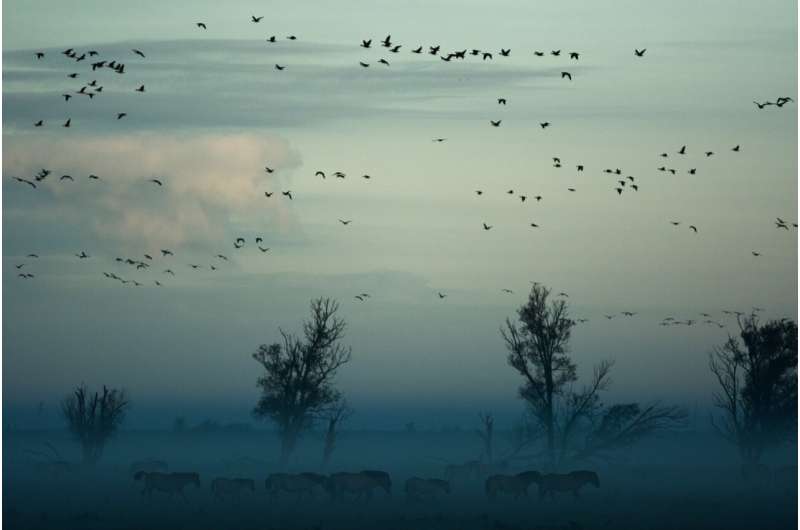This article has been reviewed according to Science X's editorial process and policies. Editors have highlighted the following attributes while ensuring the content's credibility:
fact-checked
peer-reviewed publication
trusted source
proofread
Mismatched timing: How climate change challenges bird migration

How does climate change affect the migration routes of birds? Mainly negatively, according to a new study from Yali Si from the CML at Leiden University.
The study is published in the journal Global Change Biology.
"It changes the timing of natural events differently in each region," Si explains. "This can lead to a growing mismatch between the availability of food and the supposed arrival of the birds in a certain area. For migratory birds, food must be available at precisely the right time and place," says Si. "If the growth of grass or other food occurs earlier or later, the birds face the risk of arriving too late or too early."
Climate change, however, alters the timing of the seasonal natural events such as the onset of spring. This presents a significant challenge for all animals, as they or their prey rely on vegetation as a source of food and to find shelter. However, for migratory species, such as certain birds, the problem is even more challenging.
Wrong time, wrong place?
"Birds can delay or advance their migration timing to some extent," says Si. "However, the problem is that the timing of natural events doesn't uniformly change in speed and manner across all regions. In some regions, spring arrives earlier, while in other areas, it comes later or remains unchanged. The birds travel across different regions, and in each region, the shift is different, making it quite a challenge to arrive everywhere at the right time."
The study looked at 16 migratory bird species in Asia. Si says, "These birds typically have a wintering area, a number of stopover areas where to rest and feed, and a breeding area. All of these regions are interconnected, forming a network. We wanted to know how climate change would affect how well this migration network could still facilitate the birds' migration. This is called the migration network integrity."
To determine this, Si and her colleagues compared the functioning of the networks over the past 21 years (a period with climate change), and compared this with an imaginary 21-year period without climate change (considering only the average seasonal fluctuations), explaining, "this] way, we could discern the specific impact of climate change on the integrity of the migration network for each species."
Complications for all 16 species
"We found that all 16 species are impacted," says Si. "Climate change just complicates things for them." Birds wintering relatively closer to the mid-temperate zone face more problems than birds wintering at higher latitudes. "The differences in these regions are more pronounced, leading to more difficulties for birds relying on these areas for wintering," she adds.
Previous research on migratory birds often concentrated on a single area or independently examined multiple areas, focusing on specific regions like breeding areas; for example, whether birds arrive later with a delayed onset of spring.
"However, this perspective only addresses one facet of the entire migration process," says Si. "While it's all an interconnected system, previous studies didn't take into account the whole journey, but rather examined each aspect in isolation. This way, [you] end up with an incomplete picture, underestimating the overall effect on these birds."
This type of research is now feasible because remote sensing data on climate change only now covers a period long enough to analyze trends and make meaningful observations.
Identifying actions for biodiversity conservation
Si and her colleagues' methods and findings can be valuable for improving the assessment of the vulnerability to climate change of migratory species in general. Currently, the used frameworks do not consider the fact that these species depend on the interconnectedness of different areas.
Si concludes, "By integrating our results in these frameworks, we can tailor them specifically for migratory birds. This improvement allows us to better understand the consequences and to identify actions for biodiversity conservation."
More information: Jie Wei et al, Spatially heterogeneous shifts in vegetation phenology induced by climate change threaten the integrity of the avian migration network, Global Change Biology (2024). DOI: 10.1111/gcb.17148
Journal information: Global Change Biology
Provided by Leiden University



















